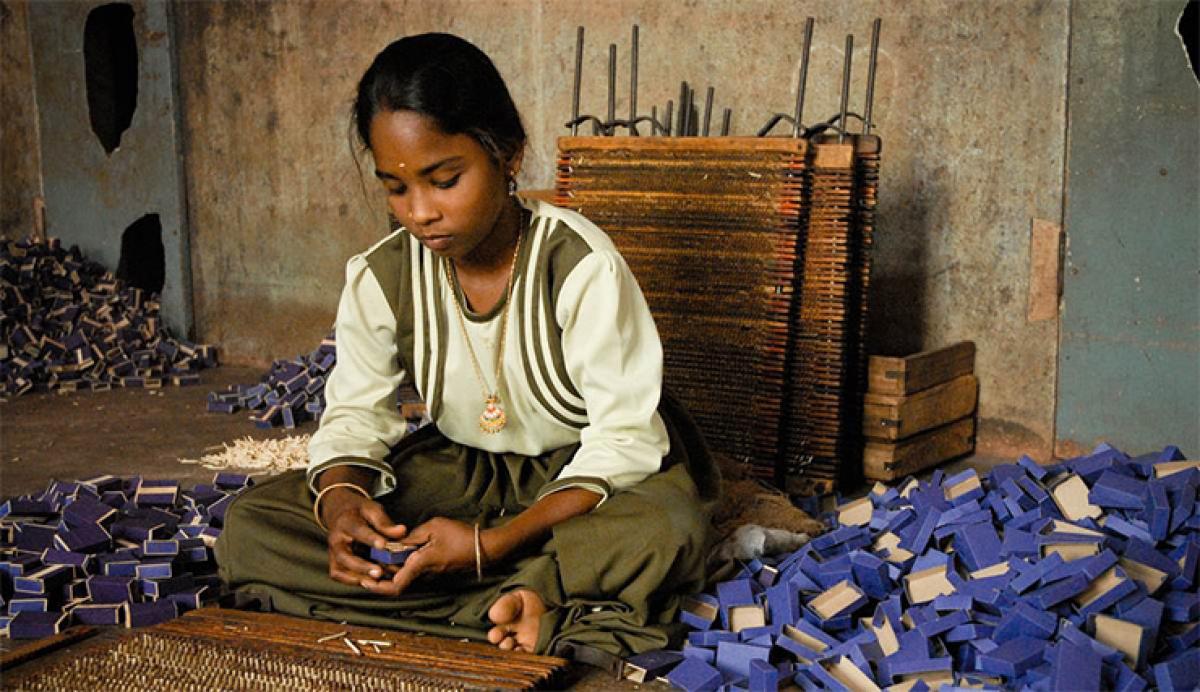Live
- 13th edition of ‘Hack AP Hackathon’ conducted
- Ayyappa devotees in thousands throng Yadagirigutta for Giri Pradakshina
- Former CM S M Krishna cremated with state honours
- Gali Janardhana Reddy announces gold-plating of Anjaneyaswamy Temple tower
- Private practitioner found operating from govt clinic
- PM stresses on thinking out-of-the-box in every sector
- Lokayukta cracks down, seizes illicit assets worth crores
- Farmers protest over delay in canal repair
- Amid continuing furore, five more maternal deaths occur in State
- Fostering a robust innovation
Just In

Kanna (aged 12), hailing from Rajahmundry, thought child labour was just natural, as many of his close friends were working. After dropping out of school in class seven, he worked as a blacksmith and as an assistant for an automobile mechanic. While working at the blacksmith\'s shop, he had to hammer away at big metal objects, like shock absorbers of large trucks.
Glaring Stats
- 22 million Indian children under 18 work to earn a living; 4.5 million are under 14
- Children who forego school increase their likelihood of being poor in later life by 30%
- Children from ST communities are twice as likely to work as children from upper castes.
Key recommendations:
- Ban all forms of child labour up to the age of 18; no exceptions
- No division into hazardous and non-hazardous – all forms of child labour to be banned
- Proper implementation of RTE Act supported by a budgetary allocation of 6% GDP
- Functional Child Protection Units across the country
Kanna (aged 12), hailing from Rajahmundry, thought child labour was just natural, as many of his close friends were working. After dropping out of school in class seven, he worked as a blacksmith and as an assistant for an automobile mechanic. While working at the blacksmith's shop, he had to hammer away at big metal objects, like shock absorbers of large trucks.
.jpg)
He once had his fingers crushed and split when the hammer landed on them instead of the metal pieces he held in them. Kanna was however lucky to have been rescued and rehabilitated by World Vision India. In a country that adopts a lenient approach towards putting an end to child labour, it becomes tough to combat both the policy-level and ground-level obstacles which effectively promote the practice.
The fact remains that child labour in any form, for any age below 18, is hazardous to children on many levels. Though the Child Labour (Prohibition and Regulation) Amendment Bill which proposes to prohibit employment of children below 14 in all sectors and adolescents (14-18) in hazardous sectors has already been introduced in the Rajya Sabha in 2012, there has been little to cheer about.
For a tangible change to take place there needs to be a blanket ban on all forms of child labour below 18. As per the latest amendment, the government believes that children can easily manage to have quality education, even if they break their backs “after school hours” in certain “family enterprises” or “audio-visual entertainment.”
By allowing children below 14 to work in select enterprises, the government is just backtracking on the commitments it made via the RTE Act that guarantees free and quality education to all children in the 6-14 age bracket. Most of the instances of child labour today happen inside homes and closed walls in the form of domestic labour, and this makes it a herculean task to identify and act upon the cases.
A well thought-out, graded rehabilitation process needs to be in place, so that children who come from such backgrounds blend well into the road ahead. Child Protection Units need to be firmly in place in each of the vulnerable areas, so that community members, government officials, teachers, parents and children themselves can be a part of the rescue and rehabilitation process.
There could be no exceptions – all forms of work by children under 18 needs to be banned. Also, the RTE Act needs to be implemented effectively, supported by a necessary budgetary allocation of 6 per cent of the GDP for it.
The author is the national director of World Vision India
By:Dr Jayakumar Christian

© 2024 Hyderabad Media House Limited/The Hans India. All rights reserved. Powered by hocalwire.com







